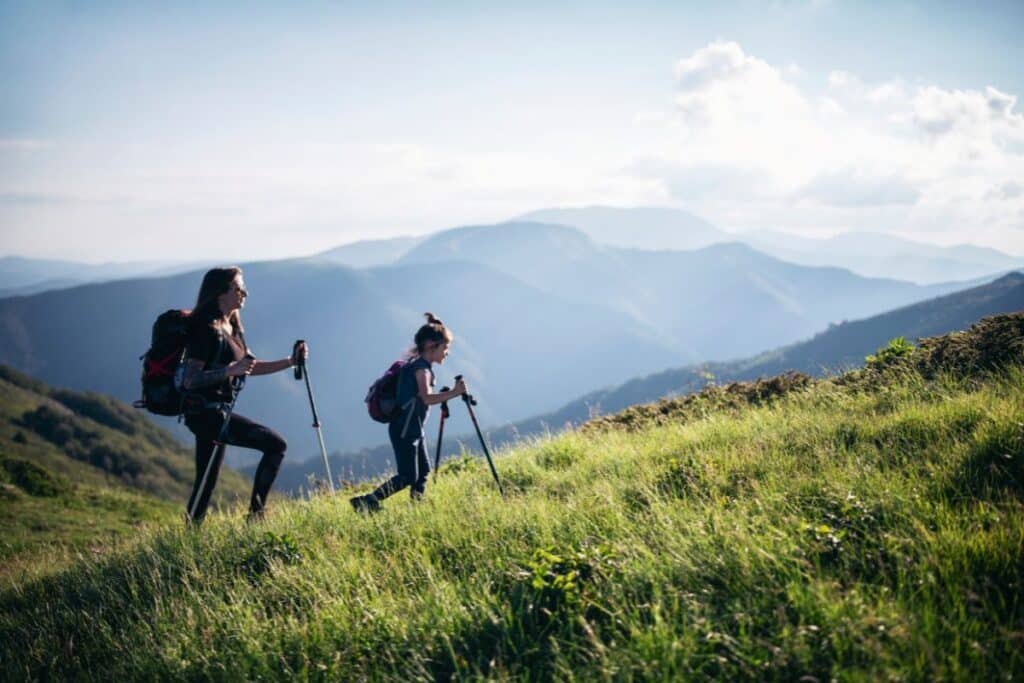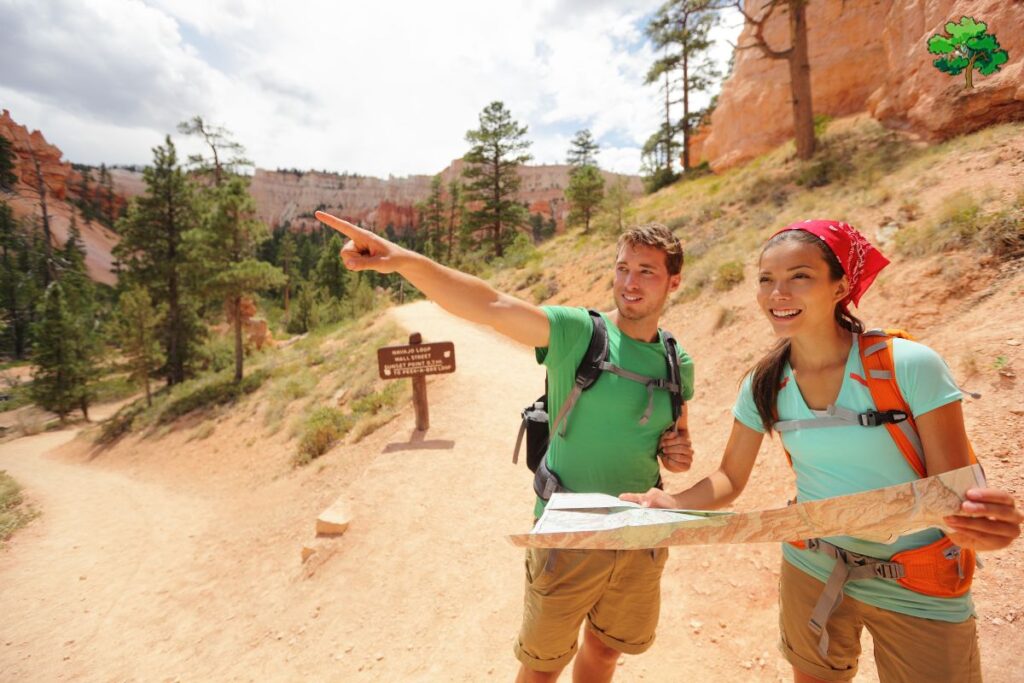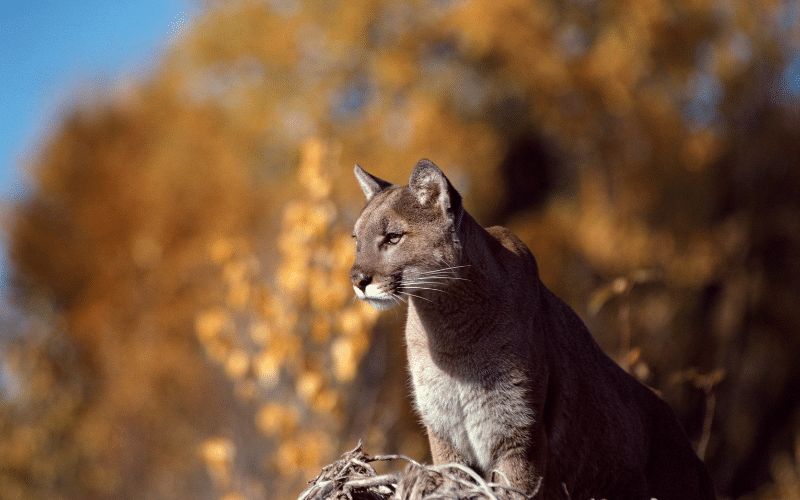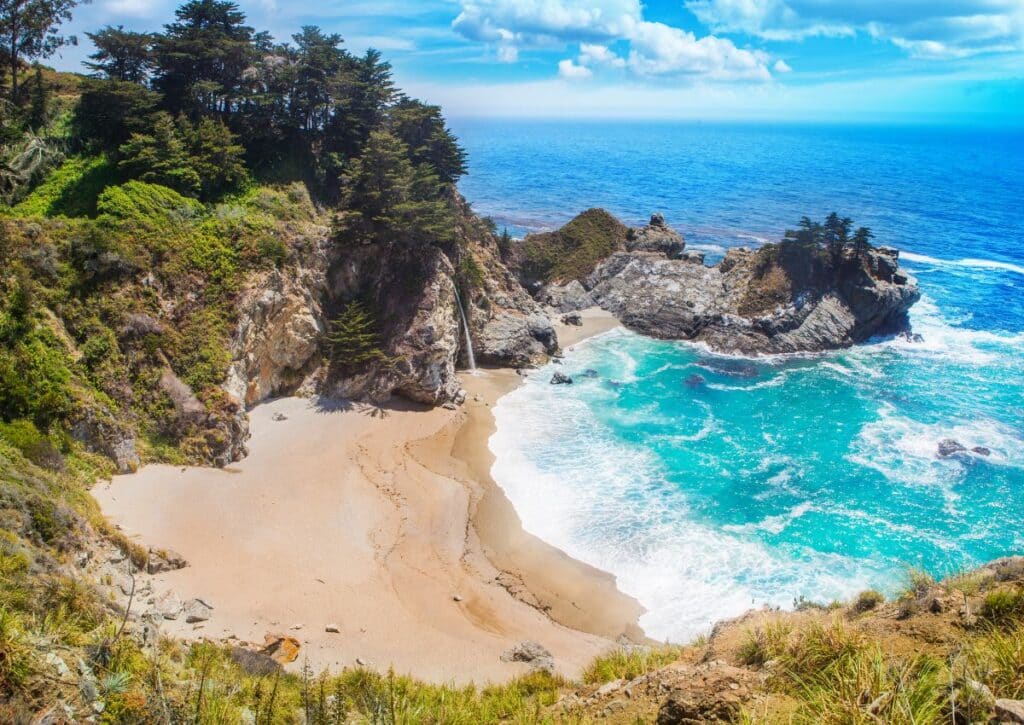Explore top 19 long distance hikes in America with our expert trail tales and tips!
Strap in, fellow adventurers! We’re about to take you on a wild journey across America’s most epic long-distance hikes – the kind that turn weekend warriors into seasoned trailblazers. After trudging, climbing, and camping our way across all 19, we’ve got the inside scoop on each.
Imagine a world where each step could be a story, each mile a memory. We’ve laced up and hit the trails, from the sunbaked stretches of the Pacific Crest Trail to the rugged, leaf-strewn paths of the Appalachian.
Pull on your hiking boots and let’s kick some trail dust! Whether it’s scaling sky-high mountain passes or fording untamed rivers, we’re going to share the nuts and bolts of what it really takes to conquer these beasts.
You’ll get a taste of what it’s like to wake up to the frosty kiss of mountain air, navigate by the stars through the enveloping forest darkness, and perhaps, if you’re lucky, lock eyes with a wandering creature of the wild.
With every punishing incline and every hard-earned descent, these trails have tested our grit and gifted us stories worth telling around a hundred campfires. Ready to make some of your own? Let’s blaze the trail together through America’s great outdoors!
Pacific Crest Trail: California, Oregon, and Washington, 2,663 miles
The Pacific Crest Trail (PCT) rose to fame after Cheryl Strayed traversed it in her memoir Wild. From Southern California to the Oregon-Washington border, this challenging trek presents both physical and psychological tests.
The entire trail, extendable to horseback riding or cycling, takes four to six months to complete. A hike on the PCT is an odyssey in its truest sense, one that requires preparation and guts. The Pacific Crest Trail Association recommends six to eight months of preparation before embarking on this journey.
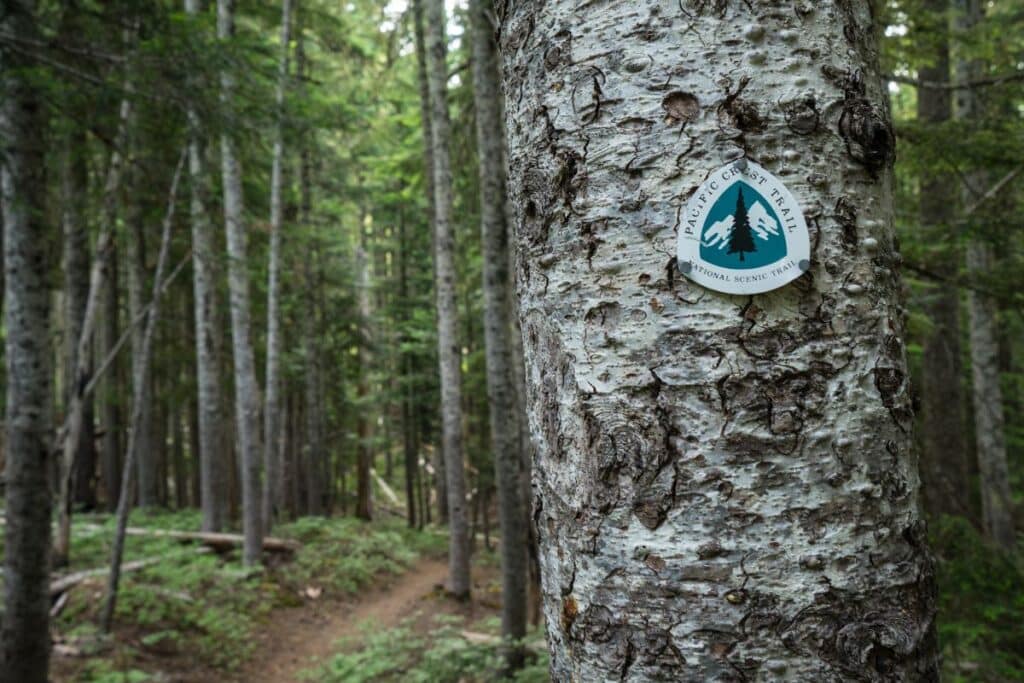
The Pacific Crest Trail (PCT) is the ultimate challenge for dedicated long-distance hikers and backpackers. Starting from the southern terminus near Campo, California, you’ll begin your journey with the thrill of the desert and a steady climb in elevation, preparing you for the looming peaks of the Sierra Nevada ahead.
The trail offers ample wildlife encounters, with potential sightings of mule deer, black bears, bighorn sheep, and a variety of bird species. The smaller critters, including lizards and butterflies, also make the trail an exciting adventure. The PCT is interspersed with incredible camping spots and designated campgrounds that offer immersive experiences in the wilderness.
However, remember that the trail can be tough. Water scarcity, especially in the southern sections during dry years, is a significant challenge. Careful planning of water sources and carrying extra supplies in desert areas are critical.
Stay updated on trail conditions and possible detours. Enjoy the journey, cherish the encounters with wildlife, and relish the solitude that nature offers on this once-in-a-lifetime adventure.
John Muir Trail: California, 210 miles
Stretching across Yosemite National Park to Mount Whitney’s summit, the John Muir Trail offers a mesmerizing journey through the High Sierras. It takes about three weeks to complete the trek, usually undertaken from north to south. The trail necessitates careful planning, as it offers no shelters and requires carrying food for the trail’s 100-mile wilderness section.
With a remarkable terrain that unveils the majestic Sierra Nevada range, it’s an excellent pick for intermediate to experienced hikers.
For a classic southbound journey, you can kick off from Yosemite National Park’s iconic Happy Isles trailhead. It will lead you into the heart of wilderness, revealing stunning waterfalls, verdant meadows, and granite cliffs.
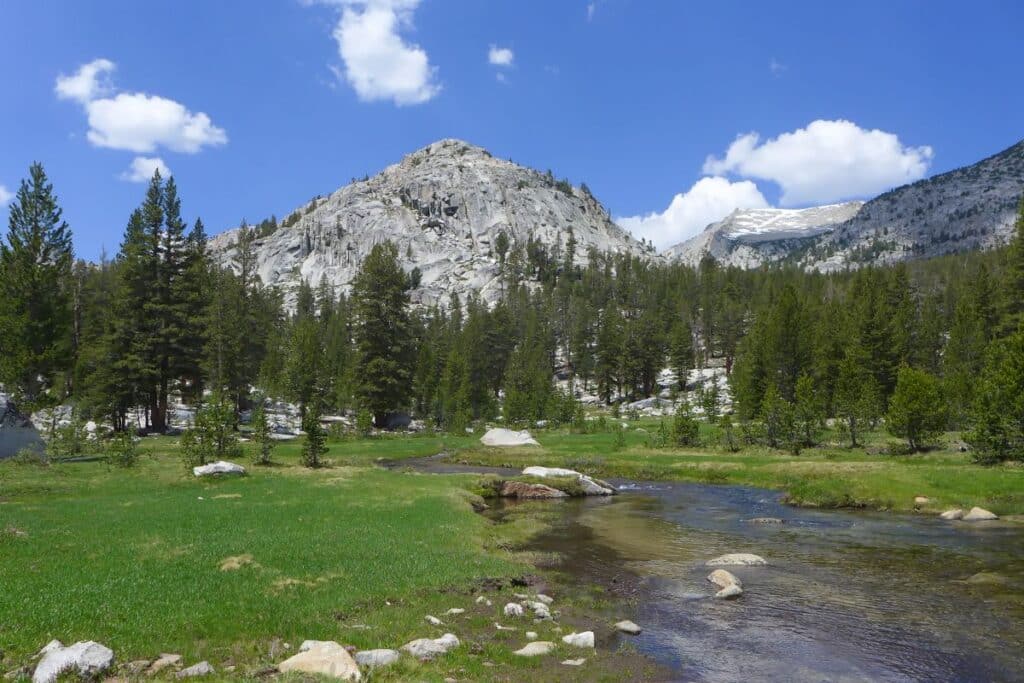
The wildlife on JMT is a fascinating mix. You may cross paths with mule deer, black bears, and perhaps even a stealthy bobcat. An array of birds, from the jay to the peregrine falcon, also inhabit these terrains, making it a bird-watcher’s paradise.
The trail is dotted with beautiful campsites offering panoramic views. Little Yosemite Valley and Tuolumne Meadows are two popular campgrounds, while secluded spots around Evolution Lake are perfect for solitude seekers.
The key to enjoying JMT lies in proper planning. Make sure to secure your wilderness permit early and adhere to Leave No Trace principles. A bear canister is a must – you don’t want a bear rummaging your food stash in the middle of the night! So, prepare wisely and soak in the surreal beauty of the John Muir Trail.
Continental Divide Trail: New Mexico, Colorado, Wyoming, Idaho, and Montana, 3,100 miles
One of the most challenging long-distance treks, the Continental Divide Trail (CDT), offers an advanced level adventure through the Rocky Mountains’ crest. The CDT is not fully marked, demanding keen navigation skills and a high degree of self-sufficiency. Despite the challenges, the trek rewards hikers with dramatic mountain scenery across five states.
This demanding trail is best suited for seasoned thru-hikers with plenty of backcountry experience. The trail offers a diverse landscape ranging from desert terrain in New Mexico to alpine environments in Colorado and Montana.
Beginning your hike from Crazy Cook Monument in New Mexico can set the stage for an authentic CDT experience. This southernmost terminus offers a rugged, remote start that characterizes much of the trail’s spirit, setting the tone for the miles to come.
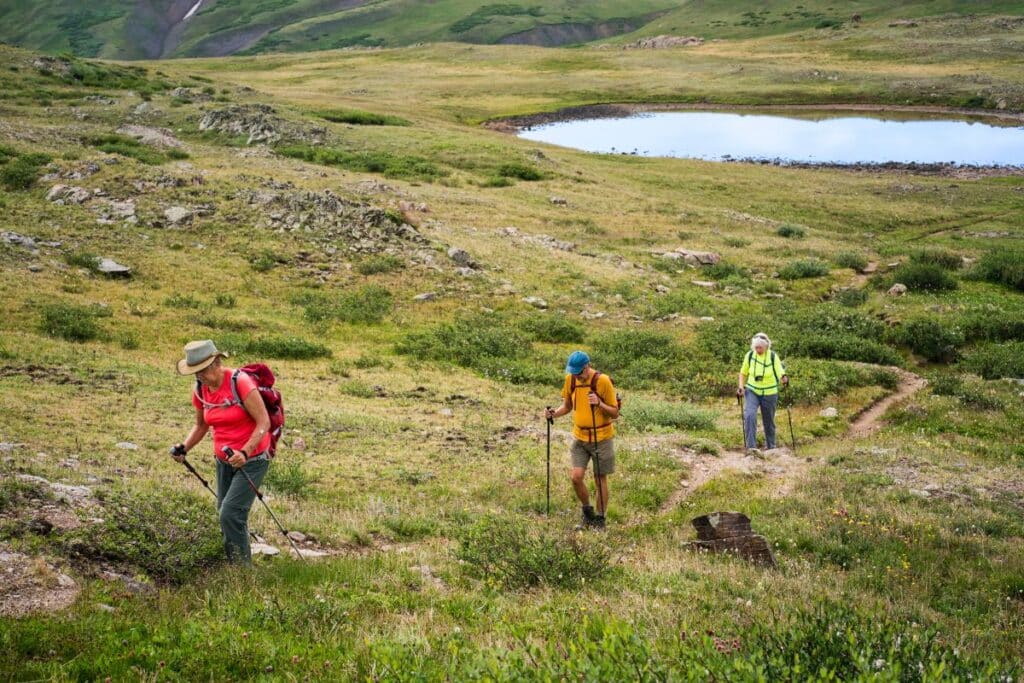
This trail is a wildlife enthusiast’s dream, with a chance to encounter animals from all walks of North American fauna. From the elusive lynx in Colorado’s mountains to the herds of pronghorn antelope in Wyoming’s high plains, there’s always something to observe. And don’t forget about the grizzly bears in Montana’s Glacier National Park!
CDT boasts a plethora of camping options. New Mexico’s Gila Wilderness, Colorado’s San Juan Mountains, and Montana’s Bob Marshall Wilderness are among the top picks. However, a number of sites are dispersed and without designated facilities, reflecting the trail’s wild and remote nature.
The best tip for the Continental Divide Trail is to be flexible and adaptable. The trail isn’t entirely marked, so good navigational skills are essential. Also, be prepared for all types of weather, as the high elevations can bring everything from snow to intense sun. So pack your gear, tie your boots tight, and brace yourself for the hike of a lifetime.
Appalachian Trail: 14 states from Georgia to Maine, 2,185 miles
Renowned as a more user-friendly trail, the Appalachian Trail provides an immersive experience of the eastern US, covering 14 states. The trail’s supportive infrastructure, including hostels, shuttle services, and restaurants, makes it a favored choice among long-distance hikers.
The Appalachian Trail is an iconic path that promises an unforgettable experience to outdoor enthusiasts of all skill levels. Whether you’re a seasoned thru-hiker aiming to conquer the entire trail or a novice looking for a serene nature walk, the AT is ready to welcome you.
One common starting point is Springer Mountain in Georgia, marking the trail’s southern terminus. This approach sets you off on a northbound journey, a direction followed by a majority of the thru-hikers. From here, you can hike your way up through 14 states, ending at Mount Katahdin in Maine.

Encounters with diverse wildlife are part and parcel of the AT journey. The Southern Appalachians are home to black bears, white-tailed deer, and over 200 bird species, while the North hosts moose and possibly a glimpse of the elusive lynx.
Sleeping under the stars is a major highlight of the AT, and the trail provides more than 250 shelters and campsites for hikers. Some standout sites include the Roan Mountain in Tennessee with its magnificent views, and the 100-Mile Wilderness in Maine, one of the most remote sections of the trail.
The best tip for hiking the AT? Embrace the trail’s nickname, “The Green Tunnel”. It’s a long trek and much of it is in the dense, verdant forest. Keep your spirits high, pace yourself, and take time to soak in the natural beauty – it’s about the journey, not just the destination.
The Long Trail: Vermont, 272 miles
As the oldest long-distance trail in the US, the Long Trail meanders through Vermont’s Green Mountains. The northern stretches of the trail offer solitude amidst nature, a rare find on the East Coast.
This trails caters to the tastes of hikers seeking a long-distance challenge without the time commitment of the more extended trails. It suits experienced backpackers seeking solitude and remarkable natural scenery.
Kick-starting your journey from the Southern Terminus in Massachusetts allows you to build up your trail legs gradually, as the northern part of the trail tends to be more rugged and physically demanding. From here, you’ll weave your way northward, traversing the heart of the Green Mountain State.
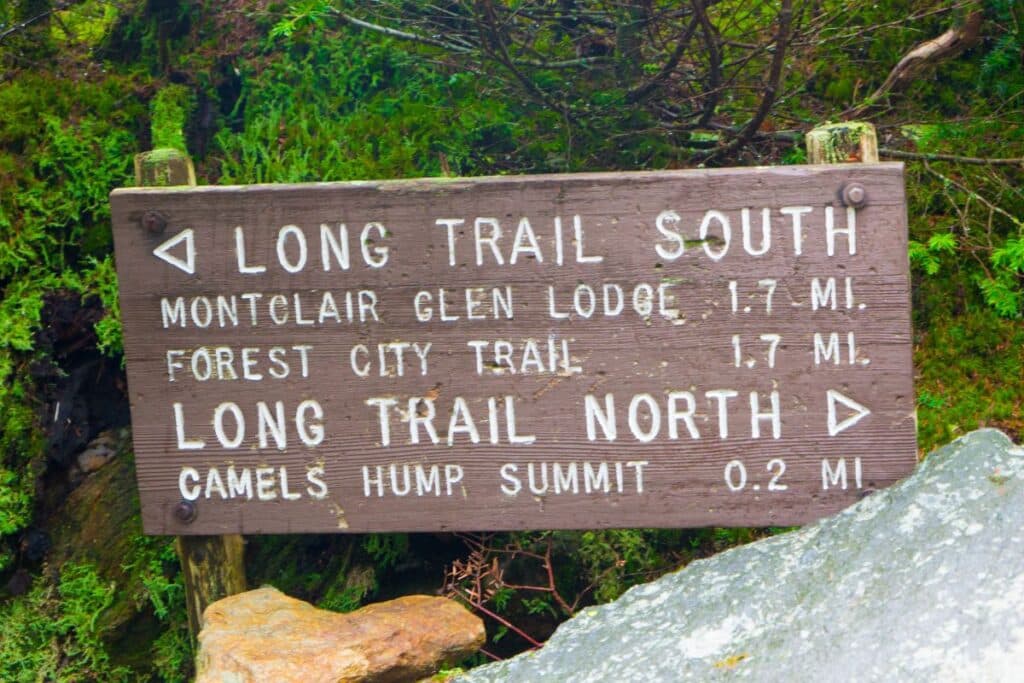
The trail provides ample opportunities to spot various wildlife. Hikers may encounter white-tailed deer, moose, black bears, and numerous bird species, such as the vibrant scarlet tanager and majestic pileated woodpecker.
A network of over 70 primitive shelters and campsites dots the length of the Long Trail. Among them, the rustic Taft Lodge, the oldest and largest on the trail, is a must-visit for its history and the panoramic views it offers from nearby Mt. Mansfield.
The most valuable tip for Long Trail hikers? Pack smart, considering the variable weather conditions. Vermont’s climate can be unpredictable, with sunny skies swiftly turning to rain or even snow in the higher elevations, regardless of the season. Waterproof gear and warm layers are essential, but remember—every ounce counts!
The Hayduke Trail: Arizona and Utah, 812 miles
Named after a character from Edward Abbey’s novel The Monkey Wrench Gang, the Hayduke Trail covers some of the most striking south-west desert landscapes. This challenging trail requires advanced water management and navigational skills.
The Hayduke Trail, with its remote landscapes and strenuous terrain, is perfect for experienced backpackers seeking solitude and an intimate experience with nature. This challenging route requires significant route-finding skills and physical fitness.
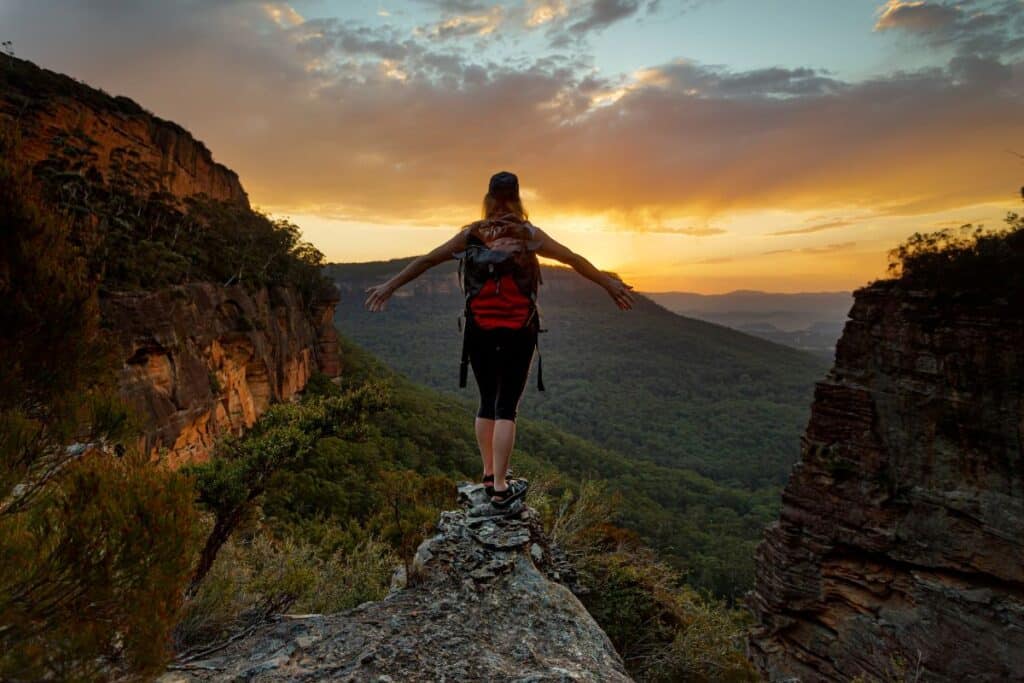
Starting your journey from Arches National Park in Utah not only gives a spectacular introduction to the trail but also allows gradual acclimatization to the desert environment. As the trail traverses through the heart of the Colorado Plateau, hikers can expect awe-inspiring rock formations and majestic canyons.
The desert ecosystem along the Hayduke Trail hosts an array of fascinating wildlife. Observant hikers may spot mule deer, desert bighorn sheep, and a wide variety of lizards and snakes. The nighttime offers an auditory spectacle as well, with the calls of coyotes echoing through the canyons.
While the Hayduke Trail doesn’t have established campsites, the wilderness offers plenty of natural sites where one can pitch a tent under a blanket of stars. A night near the Colorado River or under the towering sandstone cliffs in Grand Staircase-Escalante National Monument can be unforgettable experiences.
When it comes to the Hayduke Trail, the key tip is to plan meticulously for water. The arid desert environment means that water sources are sparse and unreliable. Hikers should study the water situation carefully, carry enough capacity to haul water for several days, and be prepared to treat water from varied sources.
The Grand Enchantment Trail: Arizona and New Mexico, 770 miles
Traversing between Phoenix and Albuquerque, the Grand Enchantment Trail uncovers the wild side of the US south-west. The trail’s zigzag route provides hikers with sufficient water sources while showcasing diverse landscapes.
The Grand Enchantment Trail is best suited for seasoned hikers eager for an immersive wilderness adventure. The trail features demanding terrain, infrequent water sources, and can test one’s navigation skills, making it more suitable for those with a fair amount of backpacking experience.
Begin your journey from the First Water Trailhead, located in the Superstition Wilderness of Arizona. This starting point offers immediate access to the wilderness and landscapes that characterize the Grand Enchantment Trail.
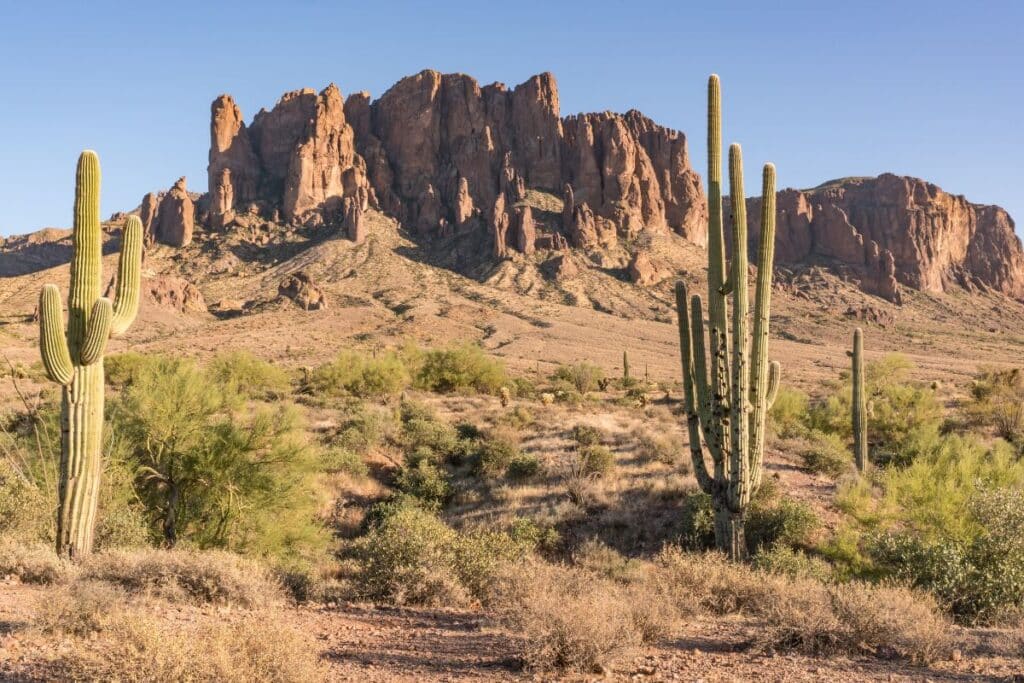
While traversing the trail, you’ll have the opportunity to encounter an array of wildlife native to the American Southwest. Keep your eyes peeled for elk, mule deer, and perhaps even a rare glimpse of a desert bighorn sheep. Birdwatchers will enjoy the trail, as it is a natural habitat for a variety of bird species.
The Grand Enchantment Trail is a wilderness trail with no designated campsites. Hikers often set up camp in flat areas near water sources or at higher elevations to enjoy stunning vistas. One of the notable places to pitch your tent is near Aravaipa Canyon, offering breathtaking views of the canyon and its unique ecosystems.
The most crucial tip for the Grand Enchantment Trail is to practice strict Leave No Trace principles. As the trail passes through numerous delicate ecosystems, it’s vital to minimize human impact and preserve the wilderness for future generations. Always remember to pack out what you pack in and respect the flora and fauna.
The Ozark Highlands Trail: Arkansas, 218 miles
Offering a picturesque view of Middle America, the Ozark Highlands Trail traverses the Ozark Mountains in Arkansas. This year-round trail offers various camping facilities, including state parks with shower facilities.
The Ozark Highlands Trail beckons hikers of all skill levels who are keen on experiencing the enchanting wilderness and rolling landscapes of Arkansas. With an array of terrain to traverse, it presents an engaging hike for beginners and experienced backpackers alike.
Begin your hike at Lake Fort Smith State Park in northwest Arkansas. This location makes for an excellent starting point, providing convenient access to the trail and the opportunity to explore the state park’s natural beauty.
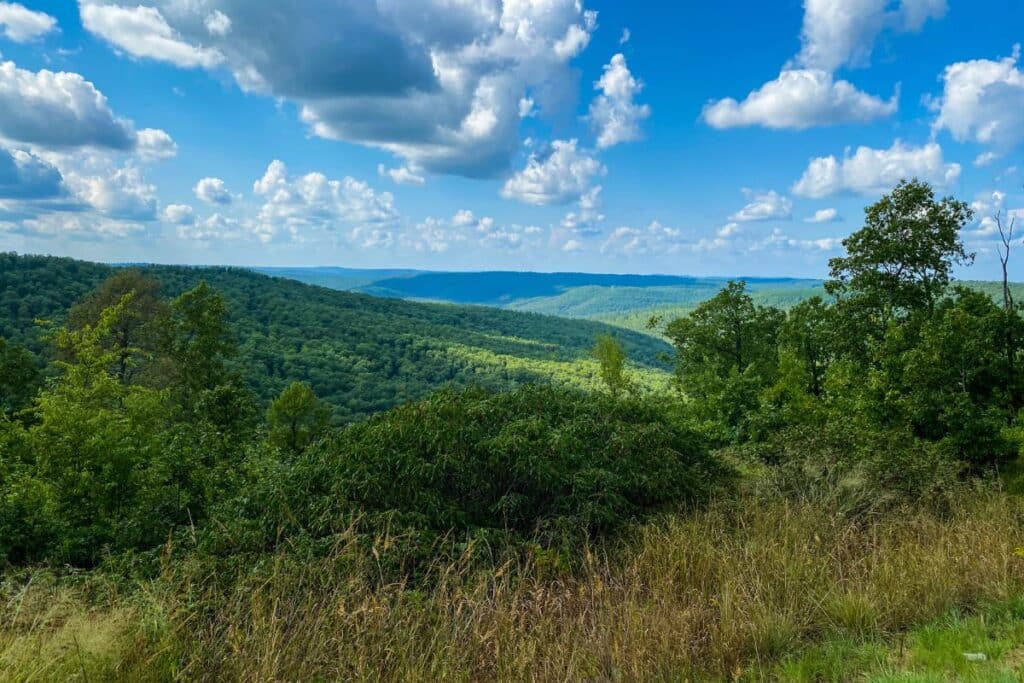
The trail’s woodland environment is rich in wildlife. While hiking, you could encounter deer, squirrels, and a variety of bird species. The trail is also home to elusive animals such as bobcats and black bears, making for exciting wildlife spotting opportunities.
The Ozark Highlands Trail offers several established campsites, which provide an excellent opportunity to rest and admire the scenery. Notable sites include the White Rock Mountain campground, renowned for its panoramic views, and the Marinoni Scenic Area, known for its picturesque streams and verdant landscapes.
The top tip for the Ozark Highlands Trail is to prepare for water crossings. While the trail offers numerous scenic creeks and rivers, it’s essential to pack water shoes and prepare for potentially wet conditions, especially during the rainy seasons.
The Ice Age Trail: Wisconsin, 1,200 miles
Tracing the edge of the former glacier, the Ice Age Trail presents an intriguing post-glacial landscape. The trail is about half marked with yellow blazes and can be navigated safely on foot.
The Ice Age Trail is a gem for hikers who appreciate geological wonders and historical richness. It offers an intimate exploration of Wisconsin’s diverse landscapes, making it suitable for novices and veteran hikers alike.
The city of Sturgeon Bay, located in the Door County peninsula, is a delightful starting point. It offers convenient trail access and presents a chance to explore the unique charm and maritime history of this lakeside city.
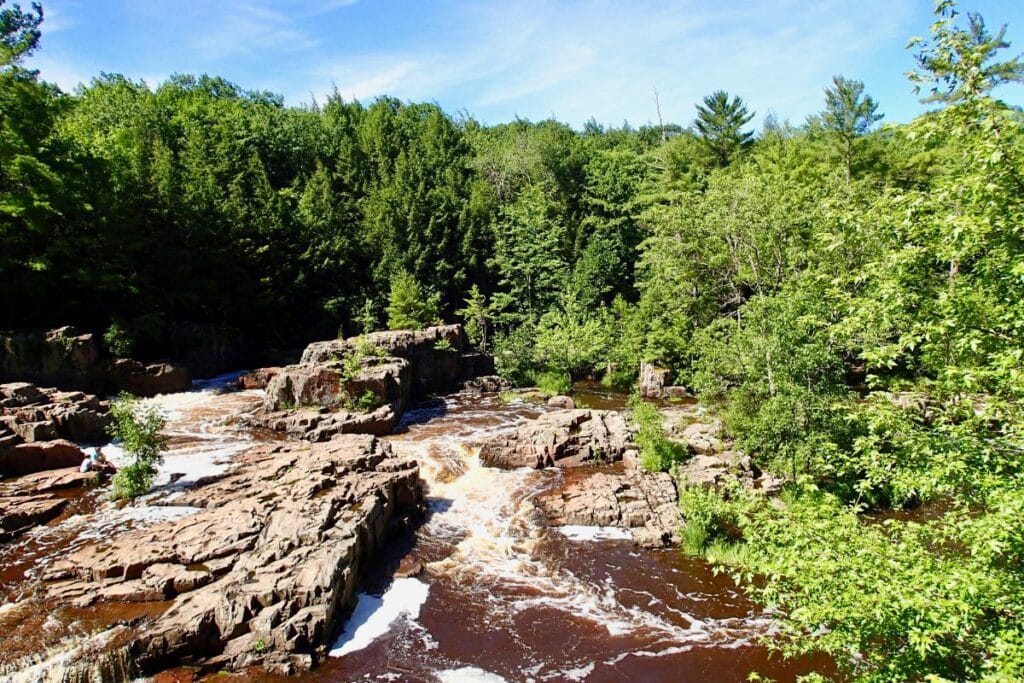
While hiking the Ice Age Trail, you can expect to encounter a variety of wildlife. This includes white-tailed deer, red foxes, and a wide array of bird species. In more secluded areas, one might even catch sight of a black bear or a coyote.
Campsites are abundant along the trail, with each offering a distinct charm. One notable site is the Kettle Moraine State Forest, which showcases the trail’s characteristic glacial features. Also worth visiting is the Chequamegon-Nicolet National Forest, known for its picturesque lakes and towering trees.
When trekking the Ice Age Trail, it’s essential to understand the unpredictable nature of Wisconsin’s weather. Be prepared for sudden changes, and pack versatile clothing that can accommodate a range of temperatures and conditions.
The Superior Hiking Trail: Minnesota, 296 miles
Overlooking Lake Superior, the Superior Hiking Trail offers a beautiful view of the largest and northernmost Great Lake. The trail is dotted with over 90 backcountry campsites and is best explored from late summer into autumn.
Avid hikers who seek out majestic views of lakes, waterfalls, and lush forests will find the Superior Hiking Trail to be an extraordinary destination. Its challenging terrain also makes it a worthy endeavor for seasoned backpackers.
One ideal starting point for this trail is the city of Duluth. Known as the gateway to the North Shore, it provides easy access to the trail and a host of amenities for hikers, including shopping and dining options.
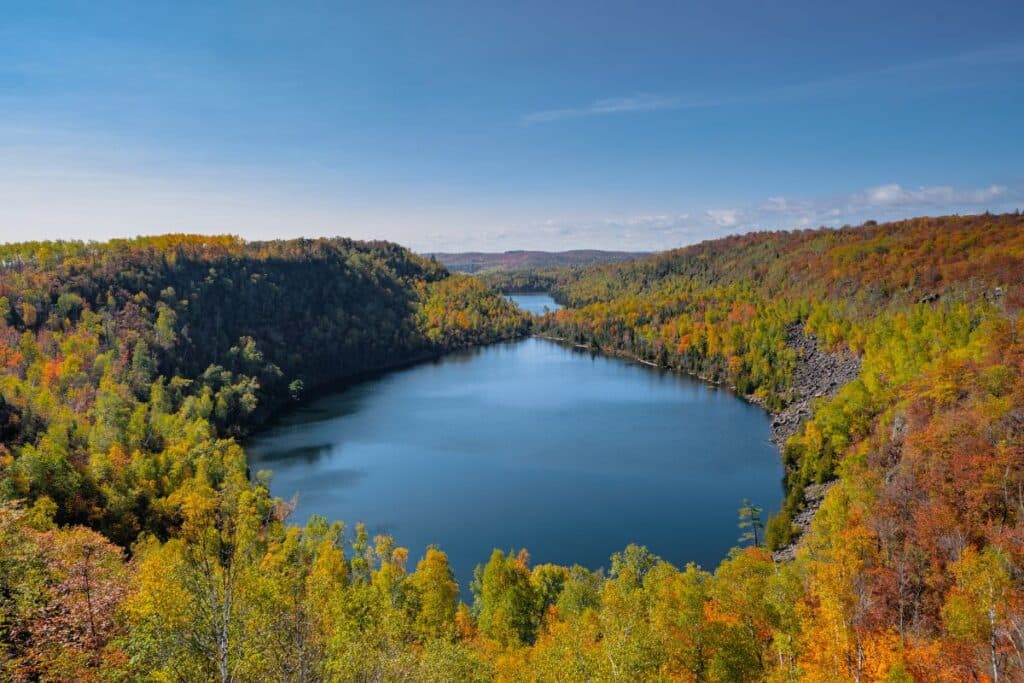
The trail teems with various wildlife, providing opportunities for nature enthusiasts to observe animals in their natural habitat. Expect to encounter white-tailed deer, squirrels, rabbits, and a rich diversity of bird species. In more remote sections, black bears and moose may also make an appearance.
An array of campsites dot the trail, allowing you to experience the serene beauty of Minnesota’s outdoors. Notable sites include the Bean and Bear Lakes site, boasting breathtaking views, and the Gooseberry Falls State Park site, known for its picturesque waterfalls.
Finally, a key tip for hiking the Superior Hiking Trail is to plan your hike during fall. You’ll be rewarded with the stunning fall foliage, adding an extra layer of beauty to your journey. Also, always remember to pack insect repellent, as mosquitoes and ticks are prevalent during warmer months.
Florida Trail: Florida, 1,300 miles
Cutting across Florida, the Florida Trail takes hikers through swamps, forests, and along river banks. This trail is one of the eleven National Scenic Trails in the US and presents a unique opportunity to experience Florida’s rich biodiversity.
The Florida Trail is a haven for hikers who crave diversity in their outdoor adventures. Spanning a variety of landscapes from swamps to forests and beaches, it’s great for both novice and experienced hikers alike.
Start your journey at the Southern Terminus in Big Cypress National Preserve. Not only is it an iconic starting point, but it also offers an immediate taste of Florida’s unique swamp ecosystem.
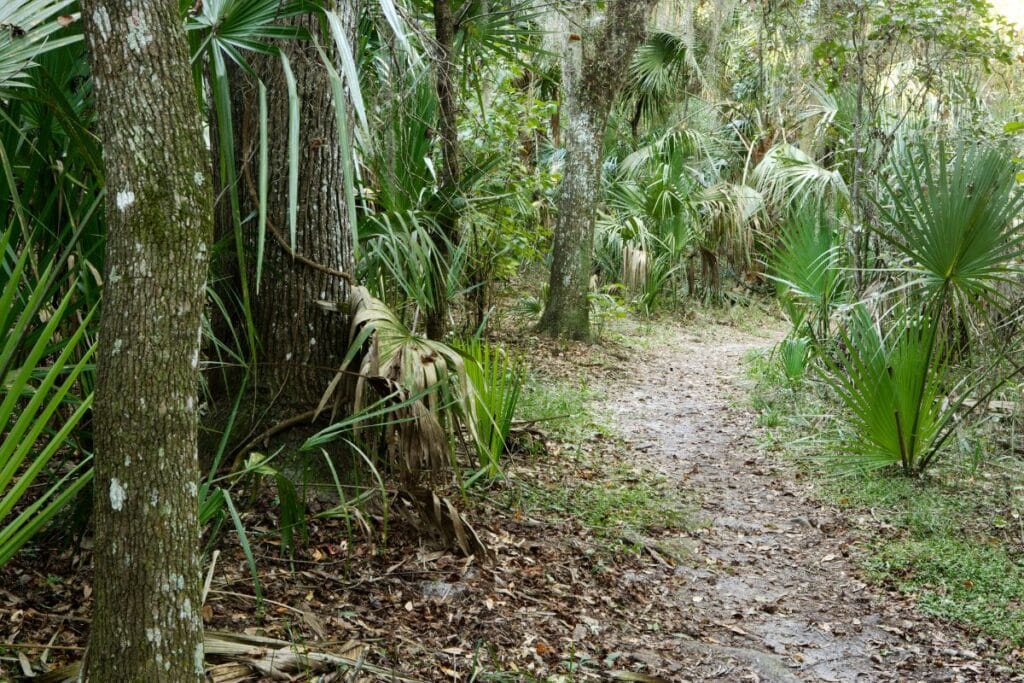
A multitude of wildlife calls the Florida Trail home. Spot alligators lurking in the marshes, the elusive Florida panther in the forests, or a manatee while crossing a river. Bird watchers will be delighted by the plethora of species, including pelicans, ospreys, and even the rare roseate spoonbill.
Numerous campsites are interspersed along the trail, offering a chance to rest and immerse yourself in Florida’s wilderness. Consider spending a night at the primitive campsite near Lake Okeechobee, one of the largest freshwater lakes in the U.S., or near the crystal-clear springs in Ocala National Forest.
For a successful Florida Trail experience, remember that it can get hot and humid, especially in the summer. Hydration is crucial, so carry plenty of water and refill at every opportunity. For the swampy sections, waterproof footwear and insect repellent are essential. Enjoy your journey by taking it slow, soaking in the diverse flora and fauna, and respecting the local wildlife.
Arizona Trail: Arizona, 800 miles
Running from Mexico to Utah, the Arizona Trail covers a variety of terrains. The trail provides hikers a unique view of the Grand Canyon, one of the most famous natural wonders of the world.
The Arizona Trail is an enticing prospect for avid hikers, mountain bikers, and equestrians who yearn for an encounter with wildly diverse terrains. It stitches together deserts, mountains, canyons, and forests, offering a spectrum of experiences for outdoor enthusiasts.
Embarking on this 800-mile journey from the Mexico border at Coronado National Memorial is an unforgettable experience. This starting point offers you a historic encounter with Spanish explorer Coronado’s entry point into the U.S. and sets the stage for the remarkable landscapes to come.
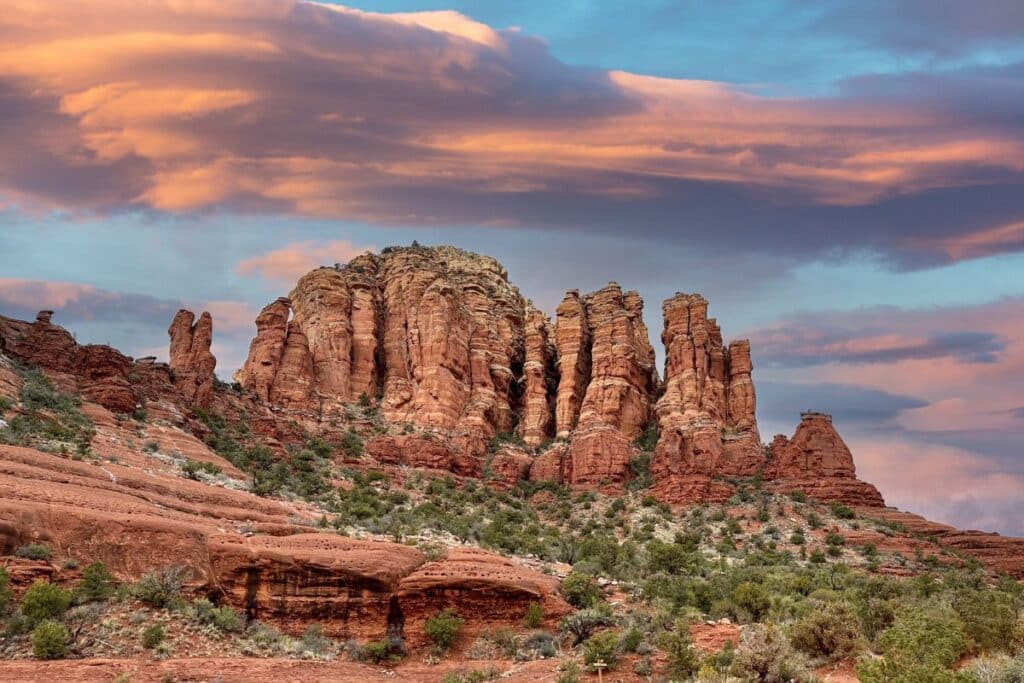
The Arizona Trail’s varied ecosystems mean you’ll encounter an array of wildlife. Watch for the iconic Gila monster in the desert, the elusive mountain lion in higher altitudes, and the Mexican spotted owl in the forests. At night, you might even hear the haunting call of coyotes.
Camping under Arizona’s expansive sky is a truly unique experience. Sites like the campgrounds in Coconino National Forest offer views of towering peaks and the chance to sleep beneath the stars.
Another exceptional site is the area near the base of the Superstition Mountains, where you can wake up to a golden sunrise illuminating the dramatic landscape.
As your top tip: Arizona’s climate can be extreme. Summers in the desert are scorching, while winters in the mountains bring snow and cold. Proper planning, having enough water, and being prepared for rapid weather changes are crucial. Also, be sure to tread lightly to preserve this breathtaking trail for future generations to enjoy.
Colorado Trail: Colorado, 486 miles
Meandering through the Rocky Mountains, the Colorado Trail connects Denver and Durango. It passes through six wilderness areas and offers a spectacular view of glaciated peaks, wildflower-filled meadows, and clear mountain lakes.
An absolute paradise for hikers, mountain bikers, and horse riders, the Colorado Trail is known for its elevations, rigorous climbs, and stunning panoramas. If high-altitude treks through wildflower-filled meadows and rugged peaks are your idea of adventure, this is the trail for you.
The most common starting point is Waterton Canyon, just outside of Denver. With the inviting call of wild canyonlands and the promise of mountain vistas, it’s the perfect place to begin your journey through the heart of Colorado’s wilderness.
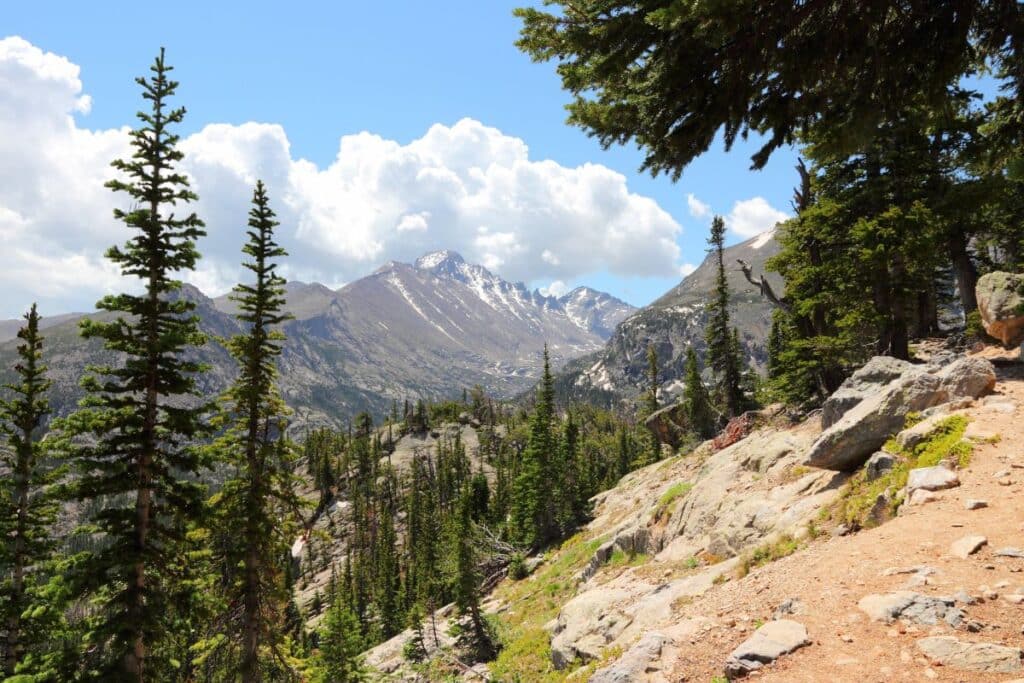
In terms of wildlife, expect to be delighted by sightings of mule deer, elk, and even the occasional moose. At higher elevations, you may see pikas and marmots, and if you’re really lucky, you might catch a glimpse of a majestic mountain lion or black bear from a safe distance.
The trail is dotted with numerous campsites, each offering unique views and experiences. Pitch your tent in secluded forests, near sparkling mountain lakes, or in the shadow of towering peaks. Sites like the tranquil meadows of the San Juan Mountains and the lush valleys near the Collegiate Peaks Wilderness are particularly stunning.
One important piece of advice to keep in mind is the altitude. You’ll be spending a lot of time high above sea level, which can lead to altitude sickness if you’re not properly acclimated. Take the time to adjust, hydrate frequently, and listen to your body. After all, this is a marathon, not a sprint.
Benton MacKaye Trail: Georgia, Tennessee and North Carolina, 300 miles
Treading along the Appalachian Mountains, the Benton MacKaye Trail is named in honor of the forefather of the Appalachian Trail. This picturesque trail offers a quieter, less crowded alternative to the AT, offering hikers the chance to savor the beauty of the Southern Appalachians. The entire trail can be conquered in about a month. It’s notably more challenging than the AT, with frequent steep ascents and descents, and less amenities, but it is also often quieter and less trafficked.
The Benton MacKaye Trail is a hidden gem, ideal for those seeking solitude and a deeper connection with nature. Its rugged paths offer a challenge for seasoned hikers and backpackers, leading them through quiet forests and across mountain ridges.
The southern terminus of the trail, Springer Mountain in Georgia, serves as a popular starting point. Here, you’ll take your first steps on this journey of discovery through the Appalachian wilderness, just as many do on the nearby Appalachian Trail.
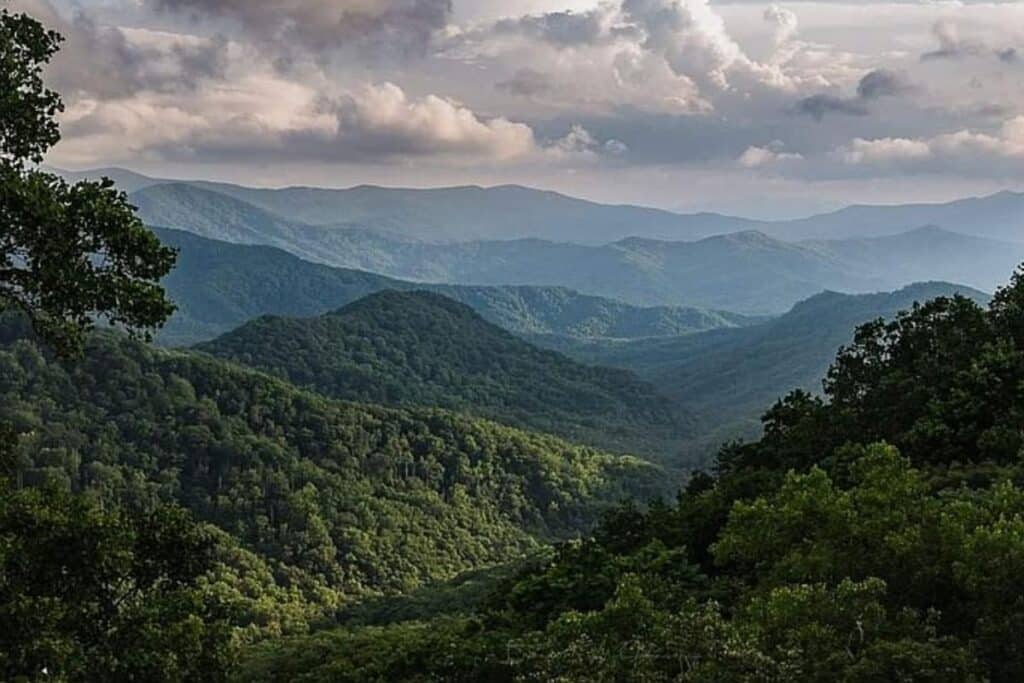
Expect to share the woods with a diverse array of wildlife. Deer, black bears, and wild turkeys make their home here. Birdwatchers will be delighted by the variety of species, from warblers to hawks, that can be spotted in the canopy.
Along the trail, campsites are strategically placed near sources of water. These remote sites offer hikers the opportunity to immerse themselves fully in the beauty of their surroundings. The campsites near the Toccoa River and those with views of the Smoky Mountains come highly recommended.
Finally, my top tip for anyone tackling the Benton MacKaye Trail is to plan your journey carefully. Unlike some of the more popular long-distance trails, resupply points can be few and far between, and cell service is often non-existent. This seclusion is part of the trail’s charm, but it also requires careful preparation.
Potato Hill Trail: Idaho, 150 miles
The Potato Hill Trail, less well-known but equally charming, weaves its way through the backcountry of central Idaho, showcasing a range of the state’s topography, from lush forests to open meadows to rugged mountain peaks. Due to its high altitude, the trail is typically snow-free only from late June to early September.
Potato Hill Trail in Idaho is a hidden treasure that caters to intermediate and experienced hikers alike. Its winding paths offer a blend of picturesque landscapes and physical challenges, perfect for those looking to push their limits while soaking up nature’s beauty.
A recommended starting point for this journey is the trailhead located near the small town of Lowman. From there, hikers can immerse themselves in the rugged beauty of the Idaho wilderness, marked by its rolling hills and lush forests.
The trail is teeming with wildlife that adds to the natural charm of the hike. Keep an eye out for deer, squirrels, and a variety of bird species. If you’re lucky, you might spot an elusive fox or even a moose.
For the camping enthusiast, Potato Hill Trail offers several campgrounds scattered along its length. One of the popular ones is the Ten Mile Campground, nestled among towering pine trees and offering stunning views of the starry Idaho night sky.
The top tip for tackling the Potato Hill Trail is to pack light but essential gear. The trail can be quite challenging in places, and having a lighter backpack can make the journey significantly more enjoyable. Also, make sure to carry plenty of water and some compact high-energy snacks.
Tahoe Rim Trail: Nevada and California, 165 miles
The Tahoe Rim Trail encircles the crystal blue waters of Lake Tahoe, the largest alpine lake in North America. The trail offers majestic views of the lake, the surrounding Sierra Nevada Mountains, and an array of wildflowers in the summer months. It can be hiked in about two weeks.
The Tahoe Rim Trail is a fantastic journey for nature lovers, hikers, and mountain bikers. Covering a diverse range of landscapes, it offers breathtaking views of Lake Tahoe and the surrounding Sierra Nevada.
To start this exceptional 165-mile loop trail, most hikers opt for Tahoe City as their kick-off point. The town is easily accessible and provides ample amenities before embarking on your adventure.
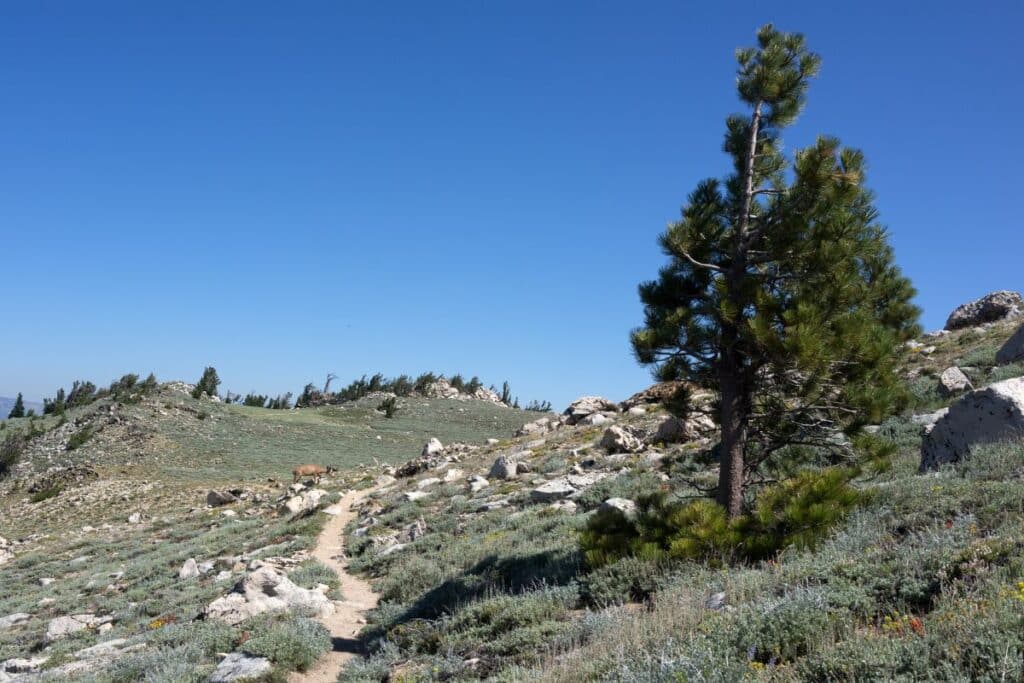
The vibrant wildlife along the trail is another reason why it’s a must-do hike. Expect to spot animals like the American black bear, mule deer, and the Sierra Nevada red fox. Bird watchers may also encounter species like the Mountain bluebird or the Steller’s jay.
Camping along the Tahoe Rim Trail can be an exceptional experience. Marlette Peak Campground is one such spot offering stunning panoramic views of Lake Tahoe. Remember, camping is only permitted within designated areas to protect the trail’s natural environment.
As a top tip, remember that the Tahoe Rim Trail is a high-elevation trail with several peaks over 9,000 feet. Therefore, preparing for altitude sickness by acclimatizing yourself and staying hydrated is crucial for a safe and enjoyable experience.
Northville-Lake Placid Trail: New York, 138 miles
Traveling through the heart of the Adirondack Park, the largest state park in the US, the Northville-Lake Placid Trail provides hikers a taste of the northeastern wilderness. Winding through dense forests, across streams, and around serene ponds, the trail can be completed in 7 to 10 days.
Adventure-seeking hikers with a taste for wilderness will find the Northville-Lake Placid Trail to their liking. This 138-mile long pathway offers a healthy mix of challenges and tranquil nature escapades, taking you deep into the heart of the Adirondacks.
For beginners, starting from the southern terminus in Northville can be beneficial as the trail initially offers less rugged terrain. However for those seeking an immediate challenge, the Lake Placid end presents steeper climbs and rugged trails.
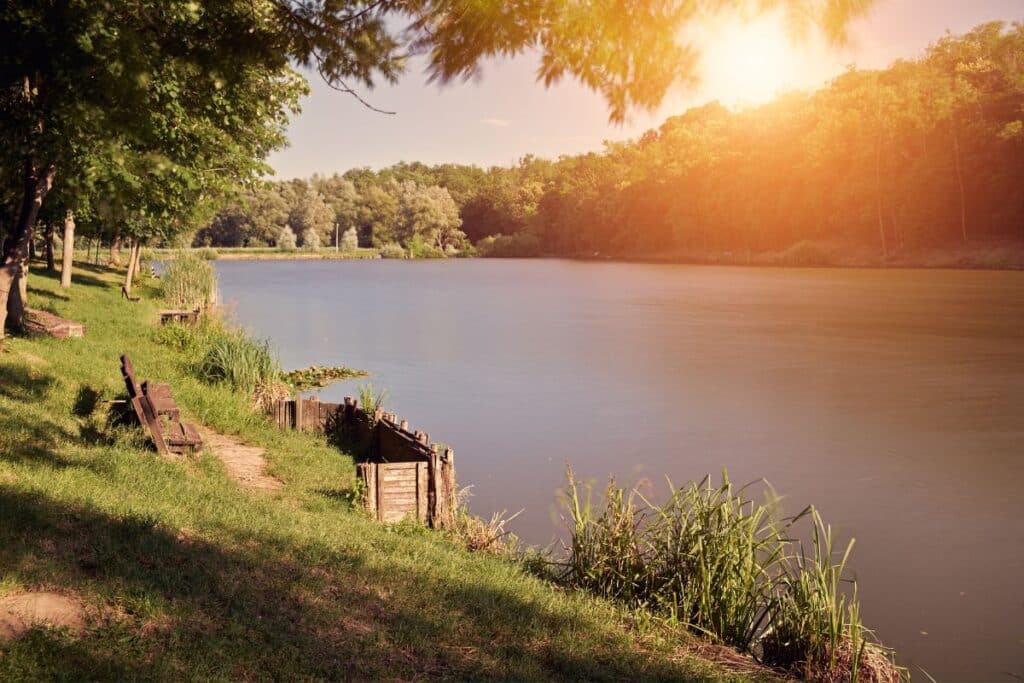
Wildlife viewing is a special treat on this trail. Encounters with white-tailed deer, wild turkeys, and even the elusive black bear are common. Keep an eye out for bird species like the great horned owl and the pileated woodpecker.
There are several designated campsites and lean-tos scattered along the trail. The West Canada Lakes Wilderness area is a camper’s delight, with serene lake-side spots that make for an unforgettable overnight experience.
For a tip, it’s crucial to remember that some parts of the trail can be quite remote and cell service is limited. Carry a detailed map and compass, and inform, someone about your hiking plan before setting off.
Wonderland Trail: Washington, 93 miles
Circling Mount Rainier, the Wonderland Trail provides breathtaking views of the active volcano and its surrounding landscapes. The trail climbs up and down the many ridges around the mountain, adding up to a total gain and loss of approximately 22,000 feet. Hiking the trail usually takes about ten days.
The Wonderland Trail, encircling Mount Rainier in Washington state, is an epic journey suited for experienced backpackers who crave a challenging and unforgettable trek through diverse ecosystems.
Most hikers opt to start at Longmire, due to its proximity to the visitor center and availability of facilities. It’s a popular starting point that sets you on a counter-clockwise loop around the majestic Mount Rainier.

Along the trail, hikers may observe a myriad of wildlife. Look out for black bears, pikas, marmots, and the ever-graceful deer. Bird enthusiasts will enjoy sightings of northern spotted owls, grey jays, and rufous hummingbirds.
The trail boasts of several scenic campsites. Summerland and Indian Bar are two of the most popular, providing breathtaking views of wildflower meadows and glacial valleys. Remember to obtain a permit for camping!
The top tip for tackling the Wonderland Trail is to be prepared for significant elevation changes. This trail is known for its cumulative elevation gain of about 22,000 feet, so conditioning for this beforehand will enhance your experience.
Bigfoot Trail: California, 400 miles
The Bigfoot Trail offers a tour of the botanical diversity of northwestern California, winding through a whopping seven wilderness areas and six wild and scenic rivers. Named after the mythical creature reportedly seen in the area, the trail features remote, rugged hiking through the Klamath Mountains, known for their high biodiversity. The trail typically takes a month to complete.
Bigfoot Trail in California is a dream for experienced hikers and botany enthusiasts. This challenging route winds through some of the world’s most extensive coniferous forests, with over 32 species of conifers to identify.
The trail traditionally begins in the Yolla Bolly-Middle Eel Wilderness, leading you north towards the majestic Redwoods. It’s remote, tranquil, and the perfect place to immerse yourself in nature.
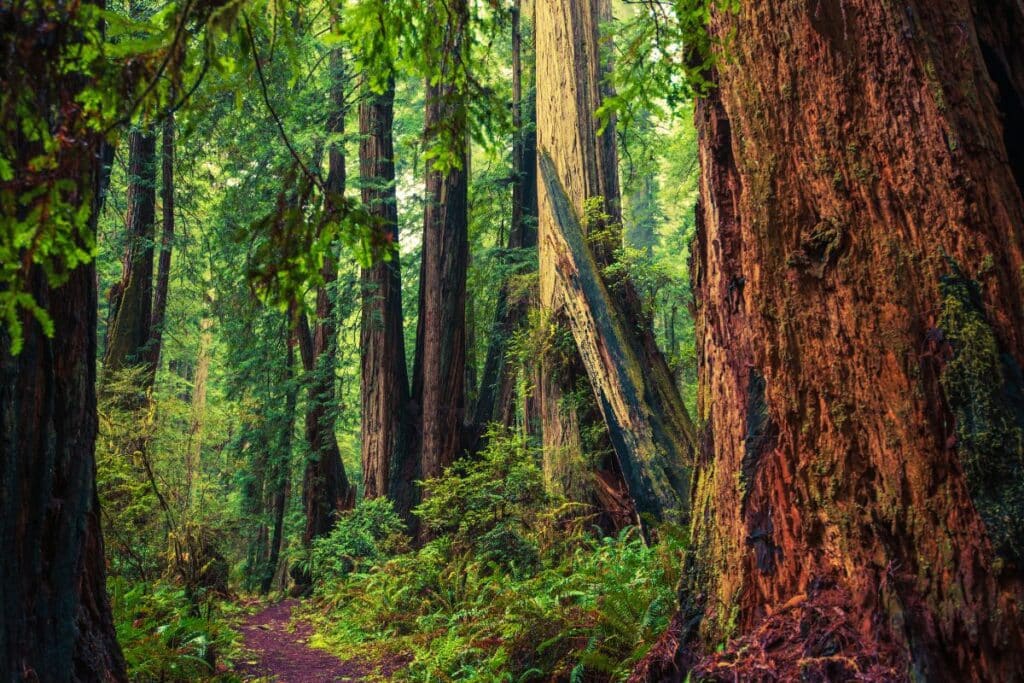
The trail’s biodiversity is unmatched; sightings of black bears, elk, and a variety of bird species are frequent. If you’re quiet and observant, you might even spot a bobcat or a mountain lion from a distance.
Campsites are scattered along the trail and are typically situated near rivers or creeks. Camping at the edge of the Redwoods in the Del Norte Coast Redwoods State Park is a highly recommended experience.
The top tip for Bigfoot Trail is to pack a quality plant guide. With the unique range of coniferous species along the trail, being able to identify them will add an enriching layer to your adventure.
Conclusion
As the sun sets on our exhilarating journey through America’s 19 top long-distance trails, we take away more than just muddy boots and well-earned tan lines. Each trail, with its unique challenges and surprises, taught us a little more about the art of survival, resilience, and humility in the face of Mother Nature’s raw power.
The silent whispers of the ancient forests, the roaring waterfalls, the boundless horizons from the mountaintops, and the vast deserts’ echoing solitude – these are the symphonies and sonnets of the Earth, sung for those who dare to listen.
But remember, these trails are not conquered – they are borrowed. They remain, timeless and patient, ready for the next adventurer to tread their paths and write their own stories in the grand narrative of the great outdoors.
So, until we meet again on these hallowed paths of exploration and discovery, keep the spirit of the wild alive in your hearts. The trails are waiting for your return. Get out there, push your boundaries, respect the wilderness, and most of all, enjoy every single step you take in these magnificent landscapes.

